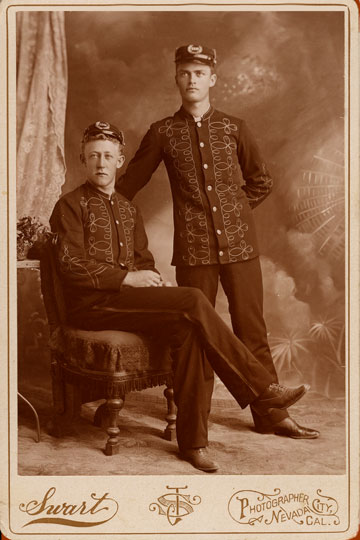A variety of portraits from the 1850s to the early 1900s
[click on the thumbnail for a larger depiction of each portrait]
Home
It is exceedingly rare to find tintypes of African Americans in California, and particularly, persons identified and repurted to have been slaves before appearing in California. The next four tintypes were purchased from a Grass Valley antiques dealer who owned a large quantity of photographs from the estate of a family named Conoway.
Hannah Harrison, possibly a slave in Maryland, who came to California (and eventual freedom) with the Conaway Family who moved from Baltimore, Maryland, to Grass Valley in the mid-1850s. Carte-de-visite sized tintype portrait of an African-American woman, photographer unknown.
Fannie Harrison, possibly a slave in Maryland, who came to California (and eventual freedom) with the Conaway Family who moved from Baltimore, Maryland, to Grass Valley in the mid-1850s. Carte-de-visite sized tintype portrait of an African-American woman, photographer unknown.
Boz Harrison, possibly a slave in Maryland, who came to California (and eventual freedom) with the Conaway Family who moved from Baltimore, Maryland, to Grass Valley in the mid-1850s. Carte-de-visite sized tintype portrait of an African-American woman, photographer unknown.
Minnie Harrison, possibly a slave in Maryland, who came to California (and eventual freedom) with the Conaway Family who moved from Baltimore, Maryland, to Grass Valley in the mid-1850s. Carte-de-visite sized tintype portrait of an African-American woman, photographer unknown.
________________________________________________________________________
Two young boys from Nevada City. Perhaps the books on the table signify that these two are avid students, or perhaps it is hoped that they will be, as the books look too bulky for such small lads. Note one boy's hat on top of the books. Carte-de-visite by Charles Ferrand, Nevada City, c. 1860s.
James H. Fowler of Grass Valley is identified as a Marshall in Virginia City, Nevada Territory. Carte-de-visite by Higgins & Johnson, San Francisco, circa 1860s.
This carte-de-visite is typical of the posing of couples with the man seated and his wife standing. The format of the cdv is called an "enamel card," a process patented and used primarily in the year 1868.This cdv is by Flanders of Grass Valley, c. 1868.
I have many portraits of children. I included this one, because it is in excellent condition having survived 150 years, and the child's clothing is classic mid-18th centruy style.This carte-de-visite is by D. Cobb on Mill Street, Grass Valley, c. 1860s.
Having one's portrait taken ususlly meant putting on one's Sunday best and leaving work clothes for work. Not surprisingly, few portraits of miners in their work clothes are found in early portraits, and when they are, they are highly valued.Carte-de-viste from the 1870s era by James Quirk of Mill Street, near Neal, Grass Valley.
This dashing gentleman wearing military trousers and over coat rakishly draped over one shoulder is identified in pencil on the reverse as Professor Ed Mueller followed by the words "Piano nevada City." Was he a piano teacher? Carte-de-visite by Charles Ferrand, c. 1860s.
Two young men in their band uniforms. Cabinet card by Swart of Nevada City, c. 1885.
The next three portraits expand the portrait medium past cabinet cards to large format cabinet cards sometimes known as "Boudoir card" or a larger size, the "Imperial card."
This portrait is an example of the Imperial Card which measures 10" x 7". You can see the complete photo and mount when you click on the thumbnail and roll over the larger jpg. The card was pasted onto a mat and framed, and when removed, residue from the paste was left along the border of the card.This is a fine example of proud portraiture of a young man in the athletic garb of the day. The photo is by Swart of Nevada City and dates c. 1890.
This is another example of the grey mount portraits that dominated portrait formats around 1900-1910. The subject's identity is unknown, but she was beautifully dressed in a witch's costume, possibly for Halloween or a theater production.The photograph is by Moore of Nevada City and Grass Valley, c. 1905.
This image leaves the strickly dark grey mount format and uses a light grey mount. The unknown sitter is another athlete proudly displaying his many medals. The portrait is by Morrell of Grass Valley, c. 1915.












































